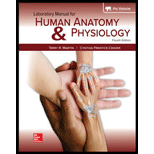
The vertebral column does not include a
- rib.
- vertebra.
- sacrum.
- coccyx.
Introduction: The spinal cord can be defined as the cylindrical bundle of the nerve fibers and connected tissue. It is surrounded in the spinal region and joins approximately all the body parts to the brain. It forms the central nervous system with the brain. The vertebral column encloses the spinal cord that travels inside the spinal canal. It is formed from the central opening in each vertebra.
Answer to Problem 1PL
Correct answer:
The correct answer is the option (a) Rib.
Explanation of Solution
Explanation/justification for the correct answer:
Option (a) Rib. A rib refers to a curved bone located in a person's chest. The ribs provide protection to the internal organs. Ribs are flexible and strong cage that is located around the soft inside parts. Hence, the option (c) is correct.
Explanation for the incorrect answer:
Option (b) Vertebra. A vertebra is one of the 33 bony segments which form the spinal cord of the humans. There are 7 cervical vertebra, 12 thoracic vertebra, 5 lumbar vertebra, 5 sacral vertebra and 4 coccygeal vertebra. Hence, the option (b) is incorrect.
Option (c) Sacrum. It is a triangular bone located in the lower part of the back. It is formed from the fused vertebrae. It is located between the two hip bones of the pelvis region. Hence, the option (c) is incorrect.
Option (d) Coccyx. It is a small triangular bone located at the base of the spinal cord in humans and some apes. It is formed by the fusion of the vestigial vertebrae. Hence, the option (d) is incorrect.
A rib refers to a curved bone located in a person's chest. The ribs provide protection to the internal organs in thorax region. Hence, the option (a) is correct.
Want to see more full solutions like this?
Chapter 13 Solutions
Laboratory Manual For Human Anatomy & Physiology
Additional Science Textbook Solutions
Concepts of Genetics (12th Edition)
Fundamentals of Anatomy & Physiology Plus Mastering A&P with eText - Access Card Package (10th Edition) (New A&P Titles by Ric Martini and Judi Nath)
MARINE BIOLOGY
Prescott's Microbiology
Campbell Biology in Focus (2nd Edition)
Essentials of Genetics (9th Edition) - Standalone book
- Part of the elbow is formed by the ________________end of the humerus. distal lateral medial proximalarrow_forwardAmong other bones, the axial skeleton includes the_____. a. thoracic cage and vertebral column b. thoracic cage and pectoral girdle c. skull and pelvic girdle d. pectoral and pelvic girdlesarrow_forwardSpondylolisthesis is the forward slipping movement of the body of one of the lower lumbar vertebrae on the vertebra or sacrum below it. ______ _______ _______ _______arrow_forward
- ______are shock pads and flex points. a. Vertebrae b. Cervical bones c. Lumbar bones d. Intervertebral disksarrow_forwardThe upper portion of the sternum is the ____________________. clavicle mandible manubrium xiphoid processarrow_forwardThe thumb is also known as the ______________ and the great toe is also known as the____________.arrow_forward
- The pedicles, laminae, and _______________________ of a vertebra form the vertebral arch.arrow_forwardWhich of these regions is not part of the upper limb? a. plantar d. brachial b. carpal e. palmar c. cubitalarrow_forwardThe vertebral column encloses and protects the _______________________.arrow_forward
- Which of the following is part of the axial skeleton?a. shoulder bonesb. thigh bonec. foot bonesd. vertebral columnarrow_forwardThe tubercles of the ribs articulate with the _______________________ processes of the thoracic vertebrae.arrow_forwardThe _______________________ at the inferior end of the sacrum is composed of several fused vertebrae.arrow_forward
 Medical Terminology for Health Professions, Spira...Health & NutritionISBN:9781305634350Author:Ann Ehrlich, Carol L. Schroeder, Laura Ehrlich, Katrina A. SchroederPublisher:Cengage Learning
Medical Terminology for Health Professions, Spira...Health & NutritionISBN:9781305634350Author:Ann Ehrlich, Carol L. Schroeder, Laura Ehrlich, Katrina A. SchroederPublisher:Cengage Learning Human Biology (MindTap Course List)BiologyISBN:9781305112100Author:Cecie Starr, Beverly McMillanPublisher:Cengage Learning
Human Biology (MindTap Course List)BiologyISBN:9781305112100Author:Cecie Starr, Beverly McMillanPublisher:Cengage Learning Concepts of BiologyBiologyISBN:9781938168116Author:Samantha Fowler, Rebecca Roush, James WisePublisher:OpenStax College
Concepts of BiologyBiologyISBN:9781938168116Author:Samantha Fowler, Rebecca Roush, James WisePublisher:OpenStax College





